Educational and Reference Resources of the Tri-Canyons
The Story of 5 Trees in the Central Wasatch Mountains
In this lesson:
- Learn about the history of logging and ecological destruction in the Central Wasatch, located near Salt Lake City, Utah.
- Learn about watersheds and the importance of protecting them.
- Learn about restoration and how the forest was replanted.
- Learn about how to use tree shape, leaves, bark, and cones to identify 5 tree species.
Learning objectives:
Students should be able to…
- Describe the history of logging and its impacts in the Central Wasatch.
- Define a watershed.
- Understand how the forest was restored.
- Use characteristics of trees to identify the 5 most common tree species in the Central Wasatch.
← Look for this Earth Icon to easily locate activities or bonus tips.
A Brief History of the Central Wasatch
Our story begins in the Central Wasatch Mountains, right outside of Salt Lake City, Utah.
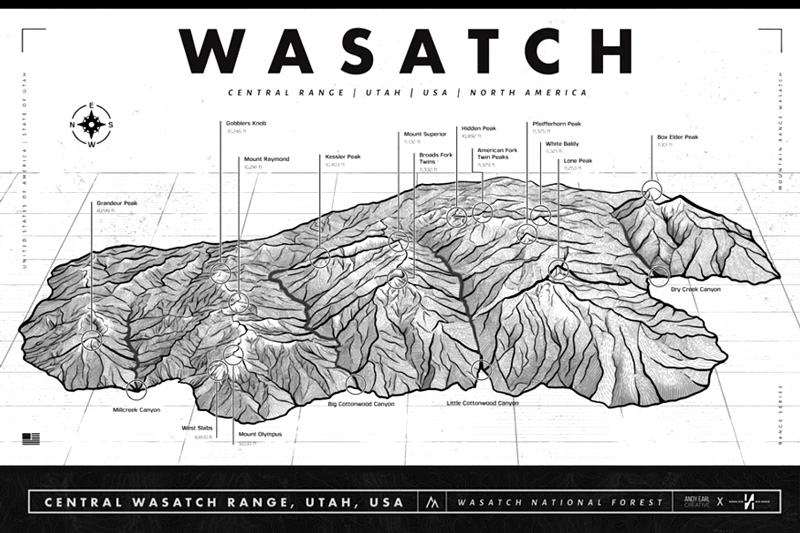 Credit: Andy Earl Creative
Credit: Andy Earl Creative
Indigenous Americans have lived in the Salt Lake Valley for at least 13,500 years. They were keystone participants in shaping the ecosystems in which they lived by modifying forests and encouraging the growth of certain useful plants. The Indigenous peoples lived in a harmonious and sustainable way with the land, in sharp contrast to the European settlers who came later.
Imagine what life would have been like for the Indigenous Americans- hunting rabbits and other larger game, gathering roots, nuts and seeds, and wearing woven sandals. How do you think their day-to-day experiences might have differed from yours today?
The European settlers arrived in the 1800’s and quickly got to work changing the landscape: they needed building material for their homes and businesses and cut down trees in the mountains. They kept cutting and cutting until there were no trees left. With no tree roots to hold the soil in place, erosion moved soil downhill into the creek. The settlers also brought their sheep and cows into the canyons, which made the water unhealthy to drink. The settlers knew they had a problem on their hands and needed to take better care of the canyons, starting with the trees.
Check your understanding: Why was cutting down trees harmful for the environment of the Central Wasatch?
Erosion: the process of soil and sediment being moved by rain, wind, and snow
 Timber mills were established throughout the Central Wasatch to turn trees into usable building materials.
Timber mills were established throughout the Central Wasatch to turn trees into usable building materials.
 Entire hillsides were cut down… and eventually, there were no trees left.
Entire hillsides were cut down… and eventually, there were no trees left.
 Credits: Central Wasatch Commission
Credits: Central Wasatch Commission
The settlers brought their sheep and cattle to graze in the canyons. The animal’s feces got into the drinking water supply and led to disease outbreaks down in the valley.
Think about it question: Why would the settlers want to bring their sheep and cows into the mountains?
Probably because of the access to water for the animals to drink, cooler temperatures in the heat of summer, and more vegetation to eat.
Hover your mouse over the pulsating dot for an answer!
Restoration: Planting Trees
In what is now Spruces campground in the Central Wasatch, a tree nursery (a place where plants are grown from seed to a desired size) was established. The U.S. Forest Service grew many different species of trees to find out which species grew the best in the Central Wasatch Mountains.
Restoration: is the process of assisting the recovery of an ecosystem that has been degraded, damaged, or destroyed

 The Spruces tree nursery, called the Wasatch Nursery, where millions of trees were grown.
The Spruces tree nursery, called the Wasatch Nursery, where millions of trees were grown.
 Replanting the forest took many people and lots of work. This planting took place from 1910- the mid-1920s.
Replanting the forest took many people and lots of work. This planting took place from 1910- the mid-1920s.
Credits: Central Wasatch Commission
Think about it: Approximately how old would the trees planted by the Forest Service be today? Do you think they are still alive?
Watershed protection
The hard lesson the settlers learned about taking care of the land so the land can take care of us in the form of clean drinking water led to laws about watershed protection. A watershed is an area of land separated by ridge lines where water all drains to the same river, stream, or lake.

Watershed: an area of land through which precipitation and all other surface runoff flows downhill into a common body of water
Credit: Seacoast Science Center
The Central Wasatch is part of the Great Salt Lake Watershed. Salt Lake City depends on the Central Wasatch for its drinking water supply. Now there are rules in place to protect the water supply like no swimming, no dogs, and definitely no sheep or cows!
Think about it: Do you think H2O that falls as snow or rain will travel faster through the watershed to the lake?
Trees of the Central Wasatch
When you look around the Central Wasatch today, most of the trees you see were the ones planted by the Forest Service. So, is the forest back to how it was before the settlers cut all the trees down? The answer is, probably not. No one is sure what species of trees were here before, and typical forests have trees of many ages, while all the trees are about the same age in the Central Wasatch.

Which tree species are growing in the Central Wasatch today?
The top 5 trees are aspen, sub-alpine fir, limber pine, Engelmann spruce, and Douglas fir. All 5 species have a story…
Aspen
Aspens are unique in many ways. Most trees reproduce by seeds falling and growing into a new tree. Not aspens! They send out horizontal roots under the ground that then sprout new trees! The largest tree in the world is an aspen called Pando which grows in central Utah. This huge grove of ‘trees’ is actually all the same individual that covers 106 acres!
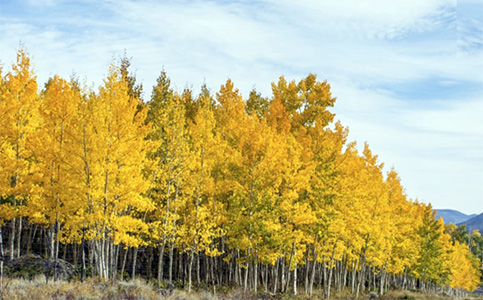
Sub-alpine fir
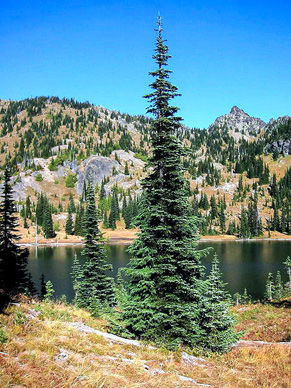 Credit: Sherwoods’ Forest
Credit: Sherwoods’ Forest
Indigenous Americans used many parts of this tree for their lives. The leaves were used as a deodorant, the bark was used to treat colds, the resin was chewed as gum and the branches were used for bedding. The seeds of this tree are dispersed in the wind.
Limber pine
Limber pine has a special relationship with the Clark’s Nutcracker, a bird species that relies on the limber pine seeds for food. The limber pine benefits from the relationship as well, because the Clark’s Nutcracker transports their seeds from the cones on the tree to rock crevasses on mountain ridges. The Clark’s Nutcrackers eat these stored seeds all winter long, but inevitably a few seeds get left behind which grow into new limber pine trees. These trees specialize in growing on these harsh, windblown ridges by having flexible (or limber) branches that won’t be broken by wind or snow. How else would the seeds get there? They can’t walk!
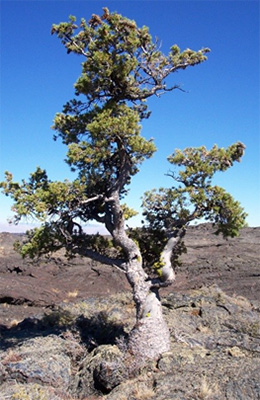
Credit: National Park Service, Craters of the Moon National Monument
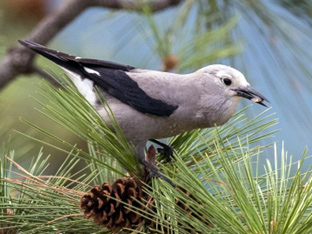
Credit: All about birds, Cornell Lab
Engelmann spruce

Engelmann spruce wood is harvested for paper making and general construction. Unfortunately, the Engelmann spruce is under threat from an insect called the Spruce Beetle which eats a layer of the bark inside the tree, eventually killing the tree. Forest managers predict that this beetle will only become a bigger threat as drought, heat, and other tree diseases make Engelmann spruce more susceptible to spruce beetles. And with climate change, the Central Wasatch is estimated to receive less rain and snowfall and increase in summer temperatures.

Douglas fir
You have almost certainly touched Douglas fir before. This is because it is one of the most commonly used woods for construction, and its wood makes up the walls, floors, and cabinets of our homes! They are also commonly grown as Christmas trees. Many birds rely on the seeds for food, and some animals like grouse, beaver, deer, and elk even eat the leaves and branches.
How to Identify a Tree?
At first glance, many of these trees look similar. Once you start to look closer at the leaves, bark, cones, and tree shape you will notice that they are all unique!
Leaves
 Sub-alpine fir
Sub-alpine fir
(Credit: USU Extension)
 Douglas fir
Douglas fir
(Credit: Virginia Tech Dendrology)

Engelmann spruce
(Credit: Northwest conifers)

Limber pine
(Credit: Washington University Arboretum)

Aspen
(Credit: Washington University Arboretum)
One of these looks very different from the rest! Leaves are a great way to tell aspen apart from the others, which are all trees with needle-like leaves, called conifers. Aspen has round, flat leaves that turn yellow and fall off in the fall. The rest of the trees are evergreen and keep their leaves year-round.
What about the other leaves? Sometimes just looking isn’t enough. We need to use our other senses.
Luckily our fingers can help us feel the difference between spruce and fir. Fir needles are softer on the ends or friendly…. Friendly Firs! Spruces are spikey when you touch the ends of the needles… Spikey Spruce! Firs also have Flat needles, while Spruces have Square needles!
Friendly, Flat Firs and Spikey, Square Spruces!
Both sub-alpine fir and Douglas fir leaves look similar, so we will use other parts of the trees to distinguish between these two species.
Limber pine needles are different from the rest because they come in bundles of five leaves that each make up one section of a round pie! If you were to take a knife and cut the bundle where the black dotted line is drawn, you would see five wedges that make up a circle.

Each ‘piece of the pie’ you see above is actually one leaf!
Credit: Ella Abelli-Amen
Bark
 Aspen
Aspen
(Credit: U of U Facilities tree tour)
 Limber pine
Limber pine
(Credit: The Gymnosperm Database)
 Douglas fir
Douglas fir
(Credit: Pierce Conservation District, WA)
 Englemann spruce
Englemann spruce
(Credit: What tree where)
 Subalpine fir bark
Subalpine fir bark
(Credit: Southwest Colorado Wildflowers)
Aspen bark is white and smooth, with…. Eyes? Those aren’t really eyes, they are places where branches used to be called branch scars. Limber pine bark is often twisted and gnarled from wind and snow. These trees tend to grow on mountain peaks in rock crevasses, and their bark is shaped by the elements. Douglass fir bark has deep ridges, while Englemann spruce is scaly… Scaly spruce! Subalpine fir is smooth with short bumpy lines going across the trunk.
Tip: Bark is a great way to tell the difference between Sub-alpine fir and Douglas fir!
Cones/Fruit
Four of these trees are conifers, which means they make cones to spread their seeds! Aspens don’t make cones, but instead have lone strings of capsules (a structure the breaks open to release seeds) that contain their seeds. Douglas fir cones have pointy ‘tails’ coming from each cone scale, which is a very helpful way to tell them apart from other species. Sub-alpine fire cones are pointing straight up into the air! This is a unique characteristic of this species.
 Douglas fir
Douglas fir
(Credit: National Park Service)
 Limber pine
Limber pine
(Credit: The Gymnosperm Database)
 Englemann spruce
Englemann spruce
(Credit: USDA Forest Service)
 Sub-alpine fir
Sub-alpine fir
(Credit: Northwest Coniferous Forests)
 Aspen
Aspen
(Credit: Go Botany)
Tree shape
We can also use the overall tree shape to help identify trees from afar! Look at which direction branches are pointing and spacing, as well as the fullness of leaves.
 Englemann spruce
Englemann spruce
 Aspen
Aspen
 Douglas Fir
Douglas Fir
 Sub-alpine fir
Sub-alpine fir
 Limber pine
Limber pine
(Tree shapes credits: Forest Service)
Test your ID skills!
1) It can be tricky to tell the difference between Douglas fir and sub-alpine fir. Which parts of the tree can help you distinguish them?
- Leaves and cones
- Leaves and tree shape
- Cones and bark
- Bark and Leaves
2) Which tree turns orange and loses its leaves each fall?
- Sub-alpine fir
- Engelmann spruce
- Douglas fir
- Aspen
- Limber pine
3) Which tree is shaped like this?

- Sub-alpine fir
- Engelmann spruce
- Douglas fir
- Aspen
- Limber pine
4) Which tree has cones that point upright, as shown in the photo:

- Sub-alpine fir
- Engelmann spruce
- Douglas fir
- Aspen
- Limber pine
5) Which tree has leaves that come in bundles of 5 that form a circle
- Sub-alpine fir
- Engelmann spruce
- Douglas fir
- Aspen
- Limber pine
Conclusions
Humans (whether that be Indigenous Americans, European settlers, or present-day Americans) have an impact on the natural areas around us. When thinking about taking care of the land, the trees are a crucial part of what makes an ecosystem healthy. Healthy trees prevent erosion and keep drinking water clean. Rules about protecting watersheds help the land, and the people who rely on the land. Restoration by planting trees can help land heal after being damaged.
Trees have many characteristics that can help us to distinguish what species they are. Engage all your senses to explore the leaves, cones, bark, and overall tree shape. Learning the names of the trees around you unlocks stories about their relationships with humans and animals.
Pick a tree in your neighborhood or school. Draw a picture of the leaves, the cones, fruits, or flowers, the bark, and the overall tree shape. Notice if there are any birds or other animals using the tree. Make a list of all the benefits that the tree provides to you.

